
Trumpeter 1/144 USS Gato (1944)
| KIT #: | ? |
| PRICE: | $45.00 MSRP |
| DECALS: | ? |
| REVIEWER: | Tom Cleaver |
| NOTES: | Guns replaced with metal ones |

| HISTORY |
When the Japanese strike force left Pearl Harbor on December 7, 1941, there were two targets they had missed, which would ultimately prove their undoing. The first was the Pearl Harbor Fuel Farm, the entire fuel reserve of the U.S. Navy in the Central Pacific, and all of it above ground; had this been destroyed, the Navy would have been forced to retreat to the U.S. West Coast, with disastrous consequences for the war in the Pacific. The second mistake was their failure to bomb the Pearl Harbor Submarine Base and the American submarines then in port.
Within hours, the Chief of Naval Operations issued the following order: “Execute unrestricted submarine warfare against Japan.” Thus was the most effective American weapon in the Pacific War unleashed. Interestingly enough, this order would eventually save the life of Admiral Karl Doenitz, head of the German Navy’s U-boat force, when he was brought before the Nuremberg War Crimes Tribunal in 1946 for having waged “unrestricted submarine warfare,” which is a war crime under the Geneva Conventions. Admiral Charles Lockwood - Commander of the Pacific submarine force - intervened on the grounds that if Doenitz was charged and found guilty, then so he should be, too. Thus Doenitz avoided a death sentence.
The Japanese attack left the Pacific Fleet unable to operate offensively, other than the submarine forces. At the outbreak of war, there were 29 submarines attached to the Asiatic Fleet in the Philippines and 27 submarines with the Pacific Fleet. The first American submarine, USS Pollock, arrived off Honshu two weeks after the Pearl Harbor attack.
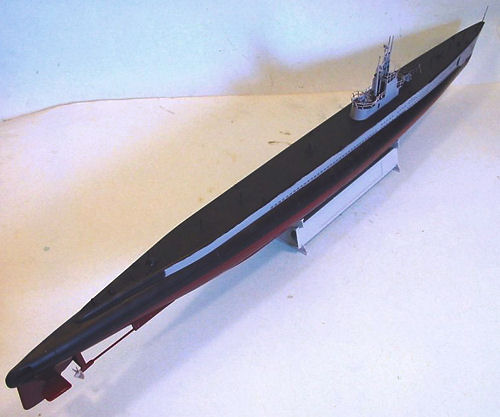 The U.S. Submarine Force,
was, man for man and unit for unit, the most effective force in the American
military during the Pacific War. 8.1 million tons of Japanese merchant vessels
were sunk by all American forces during the war; the submarines sank 4.9
million tons, 60 percent of the total. Additionally, U.S. submarines sank
540,192 tons of Japanese Navy ships including 8 aircraft carriers, 1 battleship,
11 cruisers and numerous destroyers.
The U.S. Submarine Force,
was, man for man and unit for unit, the most effective force in the American
military during the Pacific War. 8.1 million tons of Japanese merchant vessels
were sunk by all American forces during the war; the submarines sank 4.9
million tons, 60 percent of the total. Additionally, U.S. submarines sank
540,192 tons of Japanese Navy ships including 8 aircraft carriers, 1 battleship,
11 cruisers and numerous destroyers.
Combined, the two tonnage figures represent 54.6 percent of all Japanese naval and merchant vessel losses. This feat was accomplished by a force that consisted of approximately 50,000 personnel, including staff and other support positions. These 50,000 sailors were 1.6 percent of the entire U.S. Navy. This victory came at a high cost: 288 American submarines were operational throughout the war. 52 submarines were lost - 48 were destroyed in the Pacific war zones, killing 3,500 submariners, which represents the highest loss rate in the U.S. Armed Forces: 22 percent killed in action.
The submarine force confronted many significant obstacles in achieving this victory. They were not trained or equipped to fight as commerce raiders, since peacetime training had dealt with fleet operations, in accordance with the naval doctrine presented by Alfred Thayer Mahan, who held that destruction of the enemy's battle fleet was necessary to ensure control of the sea. The U.S. Submarine Force was trained to act as a part of the American battle fleet to sink major enemy warships. The fleet submarine type was designed with this concept in mind, which fortunately resulted in an effective commerce raider with the range and weapons to operate in the expanse of the Pacific. They were even air-conditioned, which led at least one British submarine commander, upon encountering U.S. submarines at Fremantle in 1945, to consider his T-class submarine a “real pigboat.”
American submariners had to overcome over-cautious and unrealistic peacetime training which held attacks were to be made from deep submergence, using sonar, in order to avoid detection and destruction by the enemy. It would take the promotion of bold and innovative submarine captains before tactics such as night surface attacks, daylight periscope attacks, and night periscope attacks were accepted. It also took many months for the Submarine Force leadership to understand how vulnerable Japan as a nation was to the destruction of merchant vessels - particularly the tankers used to carry oil from the Netherlands East Indies to the Home Islands. A country without its own oil supply that was not independently capable of producing all its food requirements was uniquely vulnerable to unrestricted submarine warfare.
The worst problem the Submarine Force faced was the scandal of defective torpedoes. American torpedoes had never been thoroughly tested against live targets. Early on, it was realized something was seriously wrong when correctly-aimed torpedoes failed to detonate or exploded prematurely. Initially, the Navy attempted to put the blame for these problems on incorrect firing solutions and ordnance handling by the crews. Only in September, 1943, following political wrangling and many missed opportunities to sink Japanese merchant and naval shipping, was the problem with defective magnetic and contact exploders corrected after a series of live firings against a submerged cliff in the Hawaiian Islands. For the first 21 months of the war, American submariners were forced to fight the enemy with weapons that didn’t work.
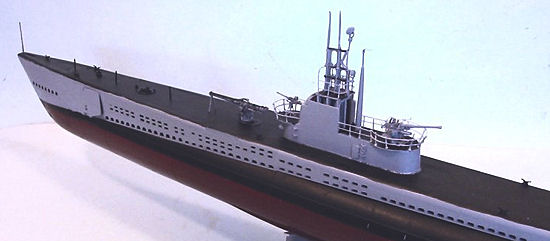 By sinking a significant
percentage of the merchant vessels used to import critical raw materials, such
as oil, bauxite, rubber, pig iron, and food, the submarines were responsible for
Japan never being able to meet the needs of its wartime civilian and industrial
economy. Thus, the Japanese were never able to adequately supply the logistical
needs of their armed forces. Aircraft production dropped because of the shortage
of raw materials and fuel. By the end of the war, when the submarines even cut
off the Japanese supply lines from the Asian mainland in the Sea of Japan, the
American submarine forces had effectively cut Japan off from the world, making
the Japanese defeat inevitable.
By sinking a significant
percentage of the merchant vessels used to import critical raw materials, such
as oil, bauxite, rubber, pig iron, and food, the submarines were responsible for
Japan never being able to meet the needs of its wartime civilian and industrial
economy. Thus, the Japanese were never able to adequately supply the logistical
needs of their armed forces. Aircraft production dropped because of the shortage
of raw materials and fuel. By the end of the war, when the submarines even cut
off the Japanese supply lines from the Asian mainland in the Sea of Japan, the
American submarine forces had effectively cut Japan off from the world, making
the Japanese defeat inevitable.
USS Gato:
USS Gato (SS-212), lead ship of her class of fleet submarine, was the first Navy ship named for the Gato, a small cat shark found along the west coast of Mexico. Her keel was laid on October 5, 1940, at the Electric Boat Company in Groton, Connecticut. She was launched on August 21, 1941 and commissioned on December 31, 1941.
After shakedown Gato departed for Pearl Harbor via the Panama Canal and San Francisco on February 16, 1942. During her first war patrol from Pearl Harbor (April 20 – June 10, 1942), she unsuccessfully attacked a converted aircraft carrier on May 3. On May 24, she was ordered to patrol the western approaches to Midway during the Battle of Midway.
Her second war patrol (July 2 – August 29, 1942), saw her patrolling east of the Kurile Islands toward the Aleutians. She experienced the problem of faulty torpedoes when he obtained four torpedo hits with unconfirmed damage to a ship on August 15 before terminating the patrol at Dutch Harbor. During her third patrol (September 4 – December 23, 1942) she operated off Kiska before returning to Pearl Harbor to receive orders to join the submarine force in Australia. On December 6, off Truk atoll, her attack on a convoy was broken off by an aerial attack and a severe depth charging by three destroyers. She arrived at Brisbane, Australia, on December 23, 1942.
Gato’s fourth war patrol (January 13, 1943 – February 26, 1943), took her to the Solomons, where she sank a transport and two cargo ships. Her fifth patrol (March 19 - June 6, 1943) saw her return to the Solomons, where she landed an Australian coastwatcher unit on March 29, and evacuated 27 children, nine mothers, and three nuns. On April 4,she was so badly shaken in a depth-charging that she returned to Brisbane for temporary repairs. She landed more Australian commandos on Bougainville on May 29, evacuated more civilians, and then conducted a reconnaissance of Tarawa before returning to Pearl Harbor on June 6, 1943.
After overhaul at Mare Island Naval Shipyard, Gato returned to Pearl Harbor in
late August, 1943, and went on her sixth war patrol (September 6 – October
28,1943) via Truk and Bougainville to Brisbane. On October 19 she attacked a
convoy with unknown damage to two large cargo ships. The seventh war patrol
(November 18, 1943 – January 10, 1944) took Gato north of the Bismarck
Archipelago where she made a coordinated attack with Ray on November 30,
sinking the Columbia Maru. On December 20, she attacked a convoy in the
Saipan-Massau traffic lanes and sank the Tsuneshima Maru. After a
two-hour depth charging, she surfaced and discovered a live depth charge on
deck at the same time the lookouts spotted two enemy escorts. She outran them
while getting rid of the depth charge by setting it adrift on a rubber raft.
This event was later memorialized as an episode in the series “Silent Service”
on Ame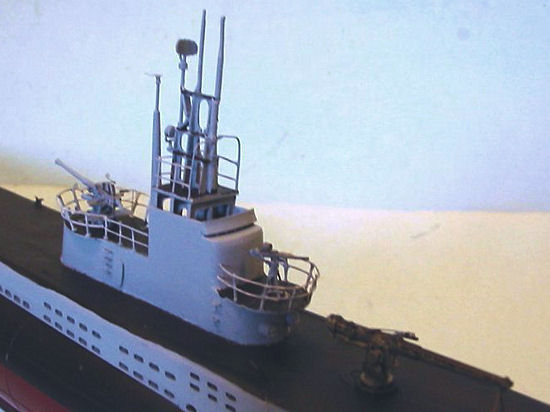 rican television in the
1950s. She concluded the patrol at Milne Bay, New Guinea, on January 10, 1944.
rican television in the
1950s. She concluded the patrol at Milne Bay, New Guinea, on January 10, 1944.
Following her eighth war patrol Gato returned to Pearl Harbor on April 1, 1944. She then took Vice Admiral Charles A. Lockwood (ComSubPac) to Midway, performed photographic reconnaissance of Woleai Island, and served as a “lifeguard” for air strikes on Truk from June11-18. Her tenth patrol saw her as “lifeguard” for the airstrikes on Chichi Jima, during which she rescued two aviators and nearly rescued a young Lt (jg) named George H.W. Bush, who was eventually rescued by the Finback. She returned to Pearl Harbor on September 2, 1944, then went on to Mare Island for an extensive overhaul that saw her gun armament extensively revised, then returned to Pearl Harbor that December.
During her 11th war patrol (January 28 - March 13, 1945,) Gato participated in a “wolf pack” with USS Jallao (SS-368) and USS Sunfish (SS-281) before returning to Guam. During April and May she operated as a “lifeguard” during the invasion of Okinawa, during which time she had a contest with two Japanese submarines on April 22-23, during which she narrowly missed being sunk. During the last week of April she rescued ten Army fliers from shallow water near the beaches of Toi Misaki, on the home island of Kyushu before returning to Pearl Harbor on June 3.
Her 13th and final war patrol saw Gato patrol off Honshu, where she received word of the cease fire on August 15 while making an attack approach on a small merchant vessel. Gato entered Tokyo Bay on August 31 and participated in the surrender on September 2. On September 3 she departed for Pearl Harbor then on through the Panama Canal to the New York Naval Shipyard, where she was decommissioned on March 16, 1946. Gato served until March 1, 1960 as a naval reserve training ship at New York City and Baltimore, Maryland.
Gato received the Presidential Unit Citation for war patrols four through eight and 13 battle stars for service in World War II.
The Kit:
This is the second “Gato” fleet submarine released by Trumpeter, the first being Gato in her original form. As produced here, the kit ostensibly represents Gato in the configuration she was modified to during her first Mare Island overhaul in 1943, until her second overhaul in 1944.
The kit is an effective substitute for those who do not have five cubic linear feet of space to store the Revell 1/72 submarine kit. The kit lacks things like propeller guards that some fleet boats carried, but which Gato never did use.
| CONSTRUCTION |
Construction is easy. Leave out the pressure hull, which is both inaccurate and invisible when finished, and you will have no problems gluing the hull halves together. The plastic is strong enough there is no need for internal bracing, and you cannot see any of the pressure hull through the limber holes if you paint the interior of the hull black. I assembled the bow planes in the stowed position.
After reviewing photographs of “Gato,” I decided I wanted to do her in the
modified configuration performed
 during
her 1944 overhaul at Mare Island, since I had more useful photographs of this
conversion and thought it looked better overall.
during
her 1944 overhaul at Mare Island, since I had more useful photographs of this
conversion and thought it looked better overall.
The first thing I noticed was that the conning tower is a scale 38 inches too
long, in the area of the “cigarette deck.” I cut down the conning tower at the
same time I cut down the bridge structure, by removing a section just aft of the
side hatch, then attaching the rear area with the widened gun deck to the
forward part of the conning tower. I also sanded off the ladders on the conning
tower and replaced them with thin brass wire. After making this conversion,
this
 then
required me to cut out the rear of the base on the main deck so the conning
tower would fit, which left a very noticeable hole. I filled that with plastic
sheet, then rescribed t
then
required me to cut out the rear of the base on the main deck so the conning
tower would fit, which left a very noticeable hole. I filled that with plastic
sheet, then rescribed t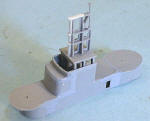 he
decking. In 1/144 scale, this was not that noticeable once it was painted.
he
decking. In 1/144 scale, this was not that noticeable once it was painted.
I
had to change the shears, with the radar moved aft of the periscopes, and a
separate structure made for the SJ radar, which I made from a piece of sprue. I
made all the railing around the cigarette deck, the foredeck, and the lookout
positions with stretched sprue. A photoetch sheet for all this is now available
from
 White
Ensign Models, and I highly recommend that over what I did.
White
Ensign Models, and I highly recommend that over what I did.
The guns provided in the kit were essentially useless. I replaced these with
white metal and photo-etch guns made by White Ensign
 Models,
with a 5" 38 caliber deck gun, a 20mm Oerlikon in the forward position and a
40mm Bofors in the rear position. Interestingly, the rear deck as done in the
kit originally has the widened area aft for the 40mm weapon, which would be
incorrect for the 20mm weapon used in that location if one did the kit “stock.”
Models,
with a 5" 38 caliber deck gun, a 20mm Oerlikon in the forward position and a
40mm Bofors in the rear position. Interestingly, the rear deck as done in the
kit originally has the widened area aft for the 40mm weapon, which would be
incorrect for the 20mm weapon used in that location if one did the kit “stock.”
The White Ensign weapons gave me fits, putting together all the 1/144-scale photo-etch, but the result is a very superior-looking weapon to what is available in the original kit.
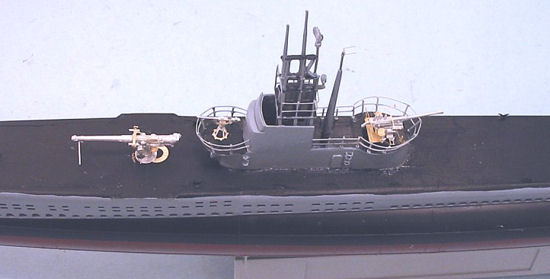 I did not put the railing
on the main deck, leaving Gato as she would have been at sea on patrol.
I did not put the railing
on the main deck, leaving Gato as she would have been at sea on patrol.
| COLORS AND MARKINGS |
Painting:
I painted Gato in the scheme she wore following her 1944 overhaul, haze grey superstructure vertical surfaces, black decks and hull upper areas, and a red waterline. With the exception of the black, these were all mixed from Xtracrylix colors. I mixed Xtracrylix Ocean Grey and Ghost Grey to come up with the shade of Haze Grey I remembered from my own time in a Navy that still wore World War II camouflage, while the waterline was painted with Tamiya Flat Red mixed with Flat Black to get Hull Red. The props were painted with Brass.
| CONCLUSIONS |
The kit is mostly accurate, with no fatal errors, and with proper research you
can do any of the US Fleet Boats, bearing in mind that there were no two exactly
the same after their first overhauls. Nautilus Models (http://nautilusmodels.com/)
does resin  conning towers for
specific submarines, with resin weapons. However, the sets cost more than the
original kit, so I stuck with my scratchbuilt corrections. A serious fleet boat
fan would be well-advised to get these sets, which are accurate and probably
more detailed than most of us can achieve on our own.
conning towers for
specific submarines, with resin weapons. However, the sets cost more than the
original kit, so I stuck with my scratchbuilt corrections. A serious fleet boat
fan would be well-advised to get these sets, which are accurate and probably
more detailed than most of us can achieve on our own.
As someone who signed “I volunteer for aviation duty/I volunteer for submarine duty” upon joining the Navy, with the hope of doing the latter, I have always been a fan of U.S. Fleet boats. I had the opportunity to spend three days at sea aboard the USS “Blackfish” in 1964, and it was an experience that has remained fresh in memory ever since.
Trumpeter’s fleet boat basic kit as it comes out of the box is good raw material for doing any of the Gato or Balao class fleet boats.
Review kit courtesy of Stevens International.
April 2007
Copyright ModelingMadness.com.
If you would like your product reviewed fairly and fairly quickly, please contact the editor or see other details in the Note to Contributors.
Back to the Review Index Page 2018